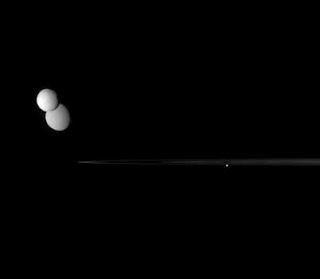Three moons
 Three of Saturn's moons and the edge of the rings are visible in this photo. The two larger ones are among the four discovered by Giovanni Cassini: Rhea (1672) behind Tethys (1684). He named them (along with Dione and Iapetus) the Sidera Lodoicea ("the stars of Louis") to honor King Louis XIV. Astronomers gave Saturn's moons numbers instead of names (Rhea began as Saturn III and became V when new moons were discovered closer to the planet, while Tethys was I and then III) until 1847, when John Herschel (son of the man who discovered Mimas and Enceladus, the new I and II) suggested that the numbers were cumbersome, and that the names of the Titans (Saturn's siblings in mythology) be used instead. With Saturn's moons now numbering over sixty, it's a good thing they took him up on the suggestion, though they ran out of Titans long ago and have branched out into lesser Greek figures and, in fact, other mythologies as well (such as Kiviuq, Paaliaq, Skathi, Fenrir, and Bebhionn). The third moon here is the outer F-Ring shepherd Pandora, tiny and discovered in 1981 thanks to Voyager I.
Three of Saturn's moons and the edge of the rings are visible in this photo. The two larger ones are among the four discovered by Giovanni Cassini: Rhea (1672) behind Tethys (1684). He named them (along with Dione and Iapetus) the Sidera Lodoicea ("the stars of Louis") to honor King Louis XIV. Astronomers gave Saturn's moons numbers instead of names (Rhea began as Saturn III and became V when new moons were discovered closer to the planet, while Tethys was I and then III) until 1847, when John Herschel (son of the man who discovered Mimas and Enceladus, the new I and II) suggested that the numbers were cumbersome, and that the names of the Titans (Saturn's siblings in mythology) be used instead. With Saturn's moons now numbering over sixty, it's a good thing they took him up on the suggestion, though they ran out of Titans long ago and have branched out into lesser Greek figures and, in fact, other mythologies as well (such as Kiviuq, Paaliaq, Skathi, Fenrir, and Bebhionn). The third moon here is the outer F-Ring shepherd Pandora, tiny and discovered in 1981 thanks to Voyager I.Check the Cassini-Huygens home for more details.





























0 Comments:
-
<-- Older Post ^ Home Newer Post -->Post a Comment
Subscribe to Post Comments [Atom]